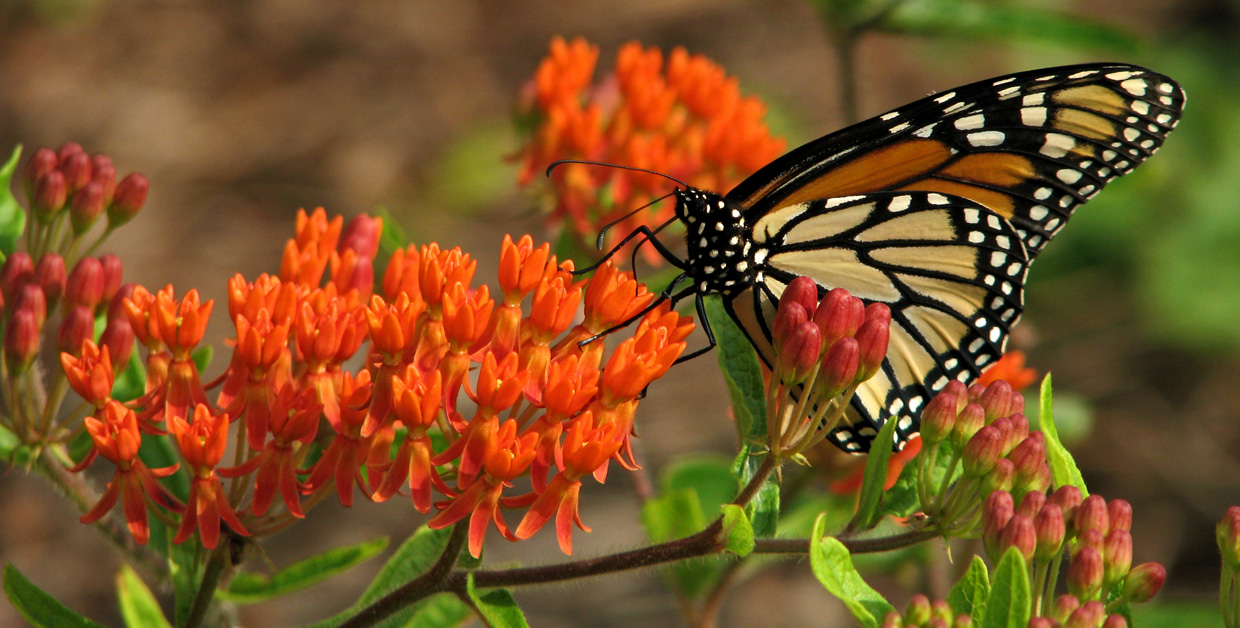Fall wildflowers and grasses feed hungry caterpillars
Pictured above: Monarch on Butterfly milkweed (Asclepias tuberosa) by Peg Urban
by Jeff Norcini
Pollinators and the native plants that support them have become increasingly important over the past couple of years as more people become aware of the imperiled Monarch butterfly and the Milkweeds (Asclepias spp.) that they rely on as their larval host plants. Larval host plants are those on which female butterflies lay their eggs, with the emerging caterpillars (larvae) consuming the foliage as they proceed through several stages of growth.
Besides Milkweeds, there are other native wildflowers and grasses here in Florida that serve as important larval host plants. Those listed below are fall-blooming native wildflowers and grasses that serve in that role and commonly occur on roadsides as well as along trails in natural areas. One of those wildflowers, the ubiquitous and oft-maligned Spanish needles (Bidens alba), also is an important nectar plant for Monarchs. Spanish needles is a “sure thing” if you want to see butterflies, especially Monarchs during their fall migration south.
If you want to attract butterflies to your landscape, including larval host plants will attract females, which in turn will attract males, as one butterfly expert wryly noted. Consider them as background plants, as the caterpillars can have voracious appetites.
For more information about Florida native butterfly larval host plants, see:
- Florida Wildflower Foundation’s Attracting Butterflies and Monarchs and Milkweeds pages
- Butterfly Gardening in Florida by Jaret C. Daniels, Joe Schaefer, Craig N. Huegel and Frank J. Mazzotti
- Florida Native Plant Society’s page for plants that attract butterflies.
Click it, don’t pick it
When you are out and about enjoying the fall beauty that Mother Nature has blessed us with, please don’t pick wildflowers. If you want to preserve the memory of a wildflower, take a picture – it will last longer. Many of our native wildflowers reproduce only by seed. Picking a flower reduces the ability of that plant to reproduce and for that population of wildflowers to sustain itself.
If you want to pick wildflowers, plant some in your yard or in containers on your patio or porch. Wildflower seed packets are available from the Florida Wildflower Seed and Plant Growers Association. Seed packets of Florida native wildflowers also may be available at garden centers specializing in Florida native plants. To find a native garden center near you, visit www.PlantRealFlorida.org.
Take Action
Contact your county maintenance yard supervisor to ask that roadside wildflowers in specific locations be spared. On state and U.S. highways, contact your Florida Department of Transportation District Wildflower Coordinator.
Fall Blooming Butterfly Larval Host Plants
Sources
- Butterfly Gardening in Florida
- FNPS – Butterflies
- Florida Museum of Natural History – Search Butterflies
- Wild South Florida
- Exploring Moths of the Florida Keys
- Butterflies and Moths of North America
Dr. Jeff Norcini is a Florida Wildflower Foundation research and planting consultant through his business, OecoHort LLC.

